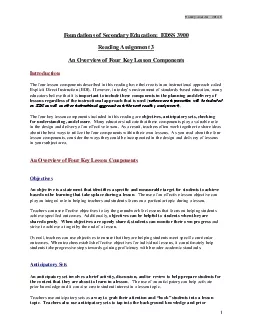

in your subject area An Overview of Four Key Lesson Components Objectives An objective is a statement that identifies a specific and measurable target for students to achieve based on the learnin ID: 884797
Download Pdf The PPT/PDF document "Reading Assignment 3 An Overview of Fou..." is the property of its rightful owner. Permission is granted to download and print the materials on this web site for personal, non-commercial use only, and to display it on your personal computer provided you do not modify the materials and that you retain all copyright notices contained in the materials. By downloading content from our website, you accept the terms of this agreement.
1 Reading Assignment 3 An Overview of Fou
Reading Assignment 3 An Overview of Four Key Lesson Components Introduction The four lesson components described in this reading have their roots in an instructional approach called Explicit Direct Instruction (EDI). However, in todayÕs environment of standards in your subject area. An Overview of Four Key Lesson Components Objectives An objective is a statement that identifies a specific and measurable target for students to achieve based on the learning that takes place during a lesson. The use of an effective lesson objective can play an integral role losure may involve having the students complete a brief assessment (i.e. an exit ticket) to determine if theyhave met the lesson objective. Closure may also involve a brief activity that helps students
2 reflect on the learning that occurred du
reflect on the learning that occurred during the lesson. Some teachers like to close a lesson by summarizing the key concepts or by having students summarize the key ideas that were contained within the lesson. Overall, closure is helpful for students as well as teachers and it is considered an important component of a lesson. Example The example on the next page is not meant to constitute a full lesson plan. However, it provides a sample of the way that a lesson can be designed to include the four key components. As you read the sample on the next page, consider the way that you would incorporate the four key lesson components for a California State HistorySocial Science Standard: 12.1-6: Understand that the Bill of Rights limits powers of federal and state
3 governments. Lesson (Content) Objectiv
governments. Lesson (Content) Objective: : When the students enter the room a prompt will be posted on the projection screen in the front of the classroom. The prompt will be Òdescribe a time when you have had your freedom taken away.Ó There will also be a The students will use the graphic organizer for a brief activity in which the teacher will name a constitutional power and the students will be asked to determine which branch of government holds the particular power. The teacher will call out the name of the constitutional power and the students will work in pairs to discuss the branch of government that holds the power. Each pair can refer to their graphic organizers and then write the appropriate branch of government on a whiteboard. The whiteboards wil
4 l be held up when the teacher provides a
l be held up when the teacher provides a cue. This activity is designed to activate prior knowledge by encouraging students to think about and review previous material pertaining to constitutional powers. This will lead into new material for the lesson by underscoring during the lesson and one question that they still have about the material. After providing them with a brief amount of time, the teacher will randomly call on students to share one item that they learned during the lesson or one question that they still have about the material. ¥ Exit Ticket Assessment: With a few minutes left in the class period, the students will complete an exit ticket. The exit ticket will ask students to briefly describe the way that each freedom in the 1st amendment serves